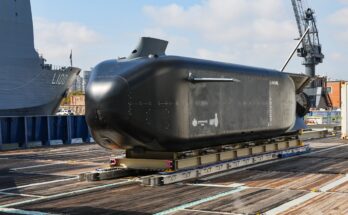Rheinmetall’s diversity has served it well during the COVID-19 pandemic. While its automotive operations suffered in the first half of 2020, defense remained resilient, maintaining its growth trend. Overall, the Rheinmetall Group posted a year-on-year reduction in sales and operating earnings in the first half of 2020.
The Group’s half-year sales fell by 7.7 percent to EUR2,597 million due to declining automotive markets. However, the Defence division continued to grow, with sales rising by 19 percent to EUR1,641 million and operating earnings jumping 75 percent to EUR122 million. Defence is expected to continue its strong performance, with sales growth of 6 to 7 percent forecast for the full year of 2020.
“Our Defence sector, with its strong performance, is Rheinmetall’s anchor of stability during the crisis,” said Armin Papperger, CEO of Rheinmetall. “In the Automotive sector, we, like the rest of the global automotive industry, were affected by the massive production declines and general market weakness in the second quarter in particular. With strict cost management, however, we were able to significantly limit the effects of the crisis.”
As it looks ahead, Rheinmetall Defence will continue to place greater emphasis on international markets while simultaneously fulfilling the modernization needs of the German armed forces. Through joint ventures and acquisitions, Rheinmetall has bolstered its operations by forming national hubs in various regions. These hubs offer the full range of the company’s products as accepted domestic suppliers. So far, Rheinmetall has established hubs in the U.S., the U.K., Canada, South Africa, Scandinavia, Australia, and the Middle East.
In addition, several major programs have helped boost Rheinmetall’s defense operations. One such initiative is the storied Boxer program being developed by the ARTEC consortium, of which Rheinmetall is a member. After struggling for years, the Boxer vehicle finally entered production in 2009 under a combined German-Dutch procurement objective of 472 vehicles. The program has had several wins of late. In March 2018, the Australian Defence Force selected the Boxer Combat Reconnaissance Vehicle (CRV) as the winner of its $3.3 billion LAND 400 Phase 2 competition. The ADF will procure 211 Boxer CRVs. A month later, the U.K. Ministry of Defence announced it would rejoin the Boxer program via the Organisation for Joint Armament Cooperation (OCCAR).
This agreement certainly helped pave the way for the formation of the Rheinmetall BAE Systems joint venture in July 2019. The new venture will play a major role in the delivery of the British Army’s new Boxers and the Challenger 2 upgrade, while also providing support to the British Army’s current armored vehicle fleets.

Lynx KF41. Source: Rheinmetall Defence
The company’s latest infantry fighting vehicle (IFV), the Lynx KF41, is also being marketed strongly around the world. Unveiled at Eurosatory 2016, the Lynx is a modular family of vehicles developed with existing technologies. The vehicle’s relatively off-the-shelf design results in a system that is lower in cost than vehicles such as the Puma IFV, which is currently being procured by the German Bundeswehr. Delivering German engineering at a competitive price point could make the Lynx very attractive to the export market.
The vehicle scored its first export win in August 2020 when Hungary became the launch customer for the Lynx KF41. Hungary ordered 218 vehicles for more than $2 billion. The deal follows an earlier acquisition of Leopard 2 tanks.
According to Forecast International’s Defense & Aerospace Companies, Volume II – International, other export opportunities for the Lynx KF41 include the Australian Defence Force’s LAND 400 Phase 3 program and a Czech requirement to replace BVP-2s. In October 2019, the Lynx was reportedly disqualified from the U.S. Army’s Next-Generation Combat Vehicle program, which will replace the Bradley. However, as of mid-2020, the Army is again restarting its Bradley replacement effort, and the Lynx may get another chance to compete for the U.S. Army’s Optionally Manned Fighting Vehicle (OMFV) procurement.
*Update* On October 20th, American Rheinmetall Vehicles announced it was teaming with Textron Systems in pursuit of the US Army’s OMFV program reboot. American Rheinmetall Vehicles is leading a US industry team that will consist of numerous US defense companies, including former teammate Raytheon Technologies, who are coming together as “Team Lynx.” If selected as the winner, the team will build the vehicle at Textron’s Slidell, Louisiana, facility.
Overall, Rheinmetall’s management has been very successful in responding quickly to shifting market dynamics. Through acquisitions, teamings, and new market initiatives, the firm is well positioned to be a formidable competitor in the years ahead.
Forecast International’s Defense & Aerospace Companies, Volume II – International includes coverage of over 90 top companies and subsidiaries outside North America, with a focus on key players in Europe and Asia. Each of the volume’s 50+ reports contains data on recent programs, mergers, and joint ventures. Among the notable corporations covered are OEMs such Airbus, Aviation Industry Corporation of China (AVIC), BAE Systems, and Embraer. Also featured are Tier I and Tier II contractors such as Rolls-Royce, Hanwha, Rafael, RUAG, and IHI Corporation. Pricing begins at $2,295, with discounted full-library subscriptions available. Click here to learn more.
A military history enthusiast, Richard began at Forecast International as editor of the World Weapons Weekly newsletter. As the Internet grew in importance as a research tool, he helped design the company's Forecast Intelligence Center and currently coordinates the EMarket Alert newsletters for clients. Richard also manages social media efforts, including two new blogs: Defense & Security Monitor, covering defense systems and international issues, and Flight Plan, which focuses on commercial aviation and space systems. For over 30 years, Richard has authored the Defense & Aerospace Companies, Volume I (North America) and Volume II (International) services. The two books provide detailed data on major aerospace and defense contractors. He also edits the International Contractors service, a database that tracks all the contractors involved in the programs covered in the FI library. More recently he was appointed Manager, Information Services Group (ISG), a new unit that encompasses developing outbound content for both Forecast International and Military Periscope.



